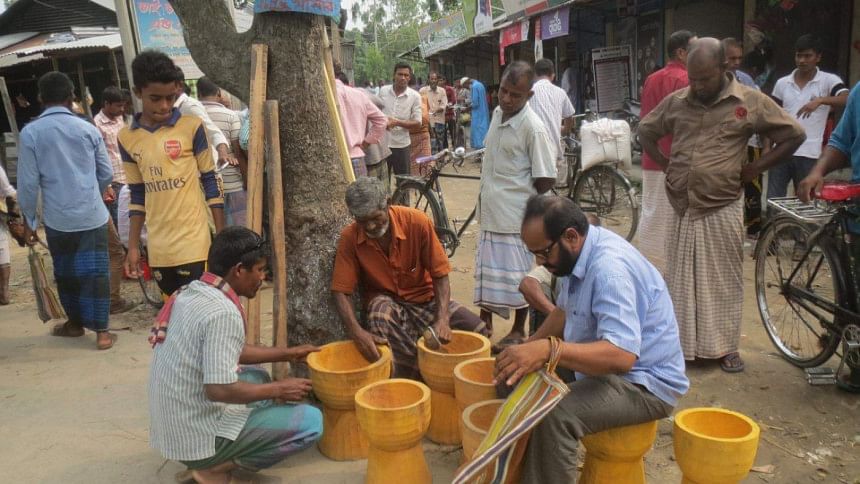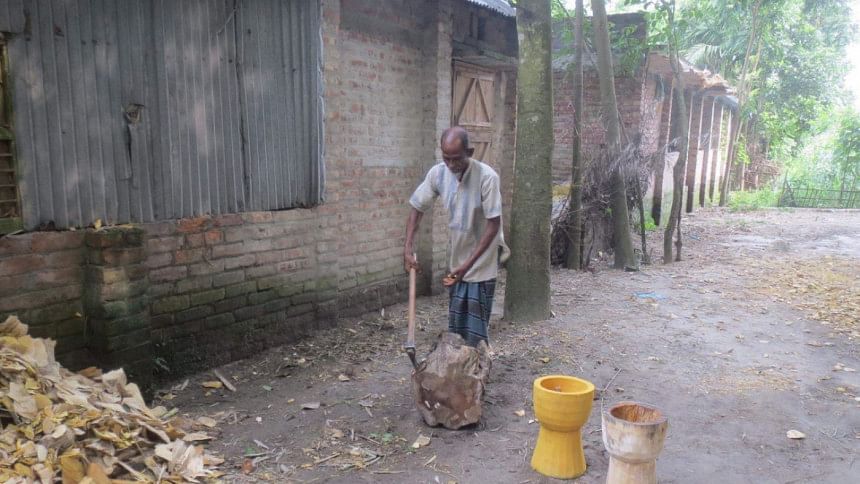The return of manual husking

Early of a morning or into the evening, it used to be that the pounding, grinding sound of the urun-gayne, as it is called in Kurigram, was as common to the village as native chickens scratching about the yard. The urun, a wooden container commonly carved from jackfruit or mango wood, together with the five-and-a-half-foot attendant pole, the gayne, made from sonalu, panial or shal timber, were mainly used by women to de-husk rice grain. For the past few decades however, thanks to introduction of mechanised huskers the sound of the urun-gayne has fallen silent. But now the simple household tool is making an unexpected comeback. Many housewives are convinced traditional husking methods offer quality results, while the exercise involved brings health benefits.
“Even though we husk our rice at the mill, sometimes I still grind spice or husk some rice grain at home,” says Selina Parvin, 33, from Kaley village in Kurigram sadar upazila. “I like using urun-gayne. It makes me sweat. When I finish I feel relaxed and sleep well at night.”

“I use urun-gayne for spice grinding and pounding raw rice,” says Shirina Khanam, 39, from Muktarum village in Sadar upazila. “I think in any household an urun-gayne set is essential. It requires physical exercise that is much needed for my health.”
Kashem Ali, 53, from Shibrum village in Kanthalbari union is a craftsman who makes them.
“They are popular items,” he says. “I sell about fifty uruns and fifteen gaynes to a value of around Tk 30,000 per month. Women use them to de-husk rice, grind chilli, turmeric and other spices conveniently, and the exercise helps control diabetes.” He notes that it's becoming more difficult to source good wood for the urun these days.
Next to Kashem in the marketplace is agriculture officer Abdul Mottalib Sarkar, 56. He's looking to buy an urun. “Some of my family members have diabetes,” he says. “They walk every day but my wife doesn't like to walk far from our home. She wants an urun-gayne set for exercise; she says rice husked in the traditional way is full of nutrients.”
Another urun purchaser, Ismail Hossain, 50, from Muktarum village in Belgachha union echoes Abdul's sentiments. “Using an urun-gayne set is useful for controlling diabetes and hypertension,” he says.
Urun come in four sizes at the bazar, designed to hold from two to five kilograms of grain at a time. Prices range from Tk 300 for the smallest size to Tk 1,000 for the largest, more than double that if quality wood is used. “I've been making urun-gayne for 56 years,” says Habibullah Mia, 65, from Shibrum-2 village in Kanthalbari. “I inherited this work from my father.” Despite renewed interest in the traditional husking implements, Habibullah says the number of artisans making urun-gayne in Kurigram is decreasing. “The main issue is locating good timber,” he says.
“There aren't enough mature jackfruit trees available.”
Kurigram Civil Surgeon Dr Aminul Islam agrees that urun-gayne offer a substitute for other exercise in many households. “But the urun-gayne doesn't exercise the legs,” he warns.
“Walking and swimming are the best exercise for controlling diabetes.”

 For all latest news, follow The Daily Star's Google News channel.
For all latest news, follow The Daily Star's Google News channel. 



Comments